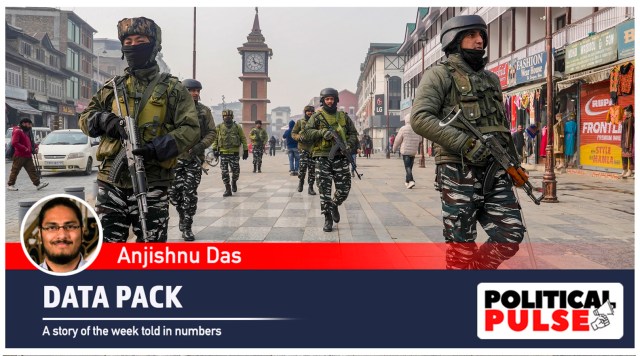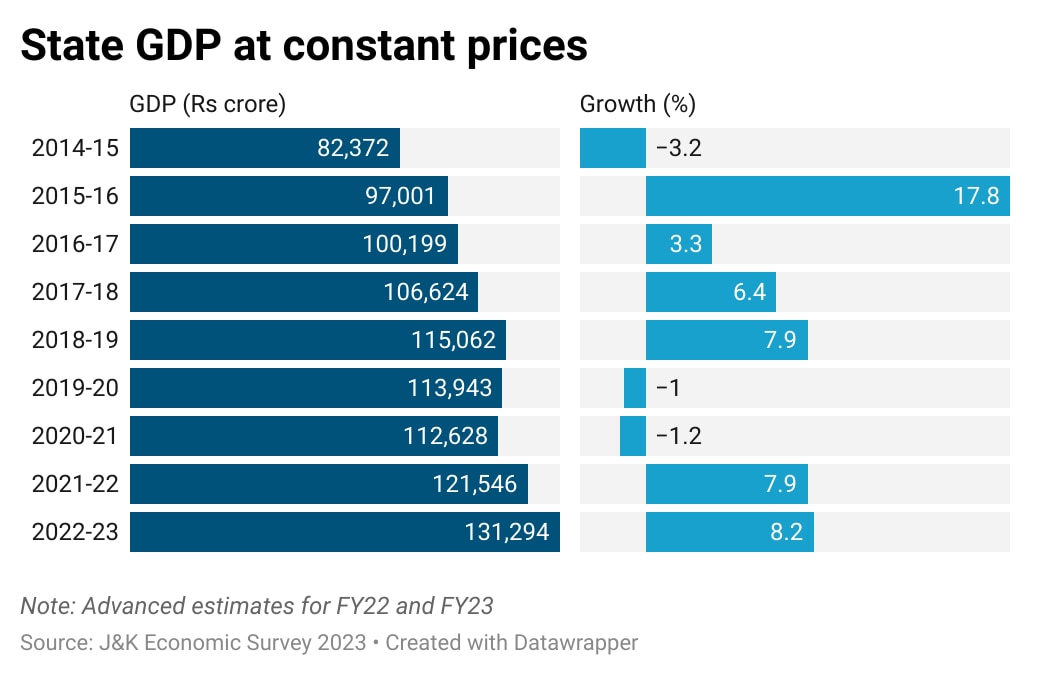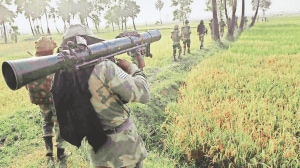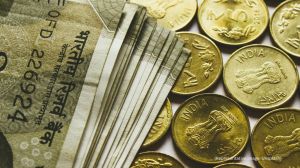J&K after Article 370: Economy and politics of Union Territory since 2019
Though GDP has started picking up in the last two years and per capita income has increased, Jammu and Kashmir’s economy has been hampered by inflation rates higher than the national average
 Security personnel patrol at Lal Chowk in Srinagar. (Photo: PTI)
Security personnel patrol at Lal Chowk in Srinagar. (Photo: PTI)Since the abrogation of Article 370 in 2019 revoking Jammu and Kashmir’s special constitutional status and splitting the state into two Union Territories, the region has been under President’s Rule and has held only two local body elections. It has been a mixed bag on the economy front since 2019.
In FY 2019-’20, J&K’s economy shrank by 1% and the following year, suffering like the rest of the country from the effects of the Covid-19 pandemic, it shrank further by 1.2%. From the following financial year, the Union Territory’s economy started recovering and in FY 2022-’23, the first year on record not affected by the pandemic, J&K’s GDP (adjusted for inflation) grew by 8% over the previous year. For the same year, the national GDP grew by 7%.
 State GDP at constant prices
State GDP at constant prices
The per capita income in J&K has grown from Rs 1.2 lakh in 2019-’20 to Rs 1.7 lakh in 2022-’23 but remains lower than the national average of Rs 1.97 lakh in 2022-’23. The consumer price index data shows that the Union Territory has higher inflation rates than the national average. Since 2018, the UT’s inflation rate has been lower than the national average only in 2020.
 Inflation rate (Consumer Price Index)
Inflation rate (Consumer Price Index)
Tourism and labour force participation
The share of agriculture in J&K’s GDP shrank from 18.4% in FY21 to 16.9% in FY23 as did the share of industry, although only marginally from 20% to 19.5%. The services sector, which includes tourism, made up for these decreases, growing from 61.6% to 63.6%.
On employment, J&K has managed to maintain a higher labour force participation rate (LFPR) than the national average. Its LFPR grew by nearly six percentage points between 2019-’20 and 2021-’22.
 Labour force participation rate
Labour force participation rate
When Article 370 was abrogated, officials at the Centre said it would open up new investment opportunities. Since the New Industrial Policy came into being in January 2021, the Union Territory has received proposals worth Rs 84,544 crore in as many as 42 industrial sectors. The actualisation of these proposals has been a tad sluggish. To date, 414 units (266 in Jammu and 148 in Kashmir) have been registered, with actual investment received on the ground at just over Rs 2,518 crore. The administration has, however, received Rs 13,777 crore in land premium against proposed units.
Electoral politics
The last Assembly election in J&K was held in 2014 but the government was dissolved after the BJP withdrew its support to Mehbooba Mufti’s Peoples Democratic Party (PDP). Upholding the constitutionality of the Centre’s decision in 2019 to revoke J&K’s special status, the Supreme Court on Monday directed the Union government to restore statehood and said Assembly elections have to be held by September 30, 2024.
Two local body elections since 2019
Of the two local body elections, one was held in October 2019 for the Block Development Council (BDC). The District Development Council (DDC) election was held in December 2020.
The BDC is the second tier of the panchayati raj system in Jammu and Kashmir and sees the participation of 26,629 panches and sarpanches. In 2019, 307 block development officers were elected, with the BJP emerging as the largest party though Independents won the most seats. The elections were held amid a clampdown in the state two months earlier following the abrogation of Article 370.
 BDC 2019 result
BDC 2019 result
The DDC elections, also under the panchayat raj system, were held across eight phases and 280 seats in 2020. The People’s Alliance for Gupkar Declaration (PAGD) — comprising the National Conference (NC), PDP, CPI(M) and three other parties, all of whom were opposed to the revocation of J&K’s special status — won the most seats (110), followed by the BJP (75). While the BJP secured control of at least six DDCs in Jammu and none in Kashmir, the PAGD won a majority in nine DDCs, all in the Valley. Since the polls, however, the Sajjad Gani Lone-led People’s Conference (eight seats) and the People’s Movement (three seats) have left the PAGD.
In two seats, results were not announced until 2022 following a citizenship dispute involving the winning candidates. The seats were ultimately won by independents backed by the NC and the Apni Party.
 DDC 2020 result
DDC 2020 result
The Delimitation Commission set up to redraw constituency maps for the newly formed UT released its final report in May 2022. The commission added seven Assembly seats in Jammu and Kashmir, taking the total up from 83 to 90. There are 43 seats in Jammu and 47 in Kashmir, with nine seats reserved for Scheduled Tribes.



- 01
- 02
- 03
- 04
- 05




























